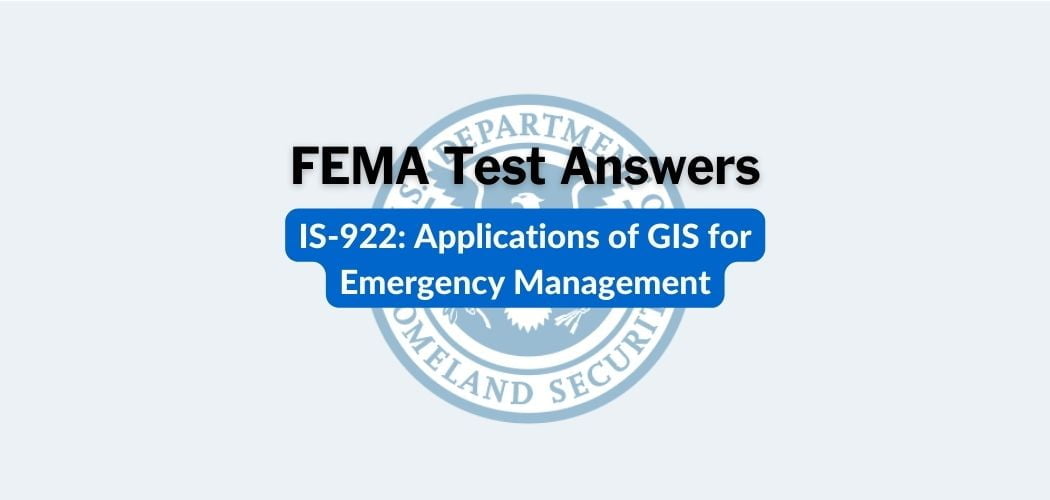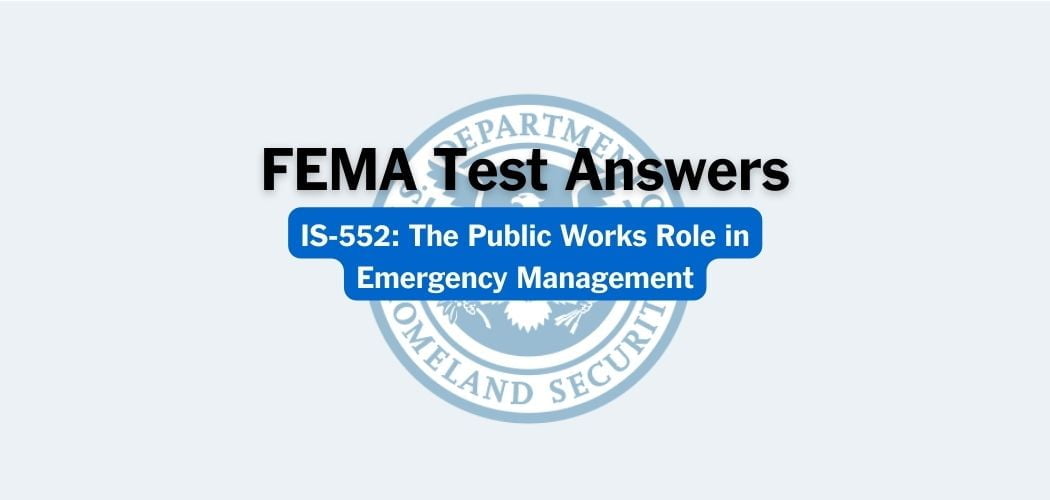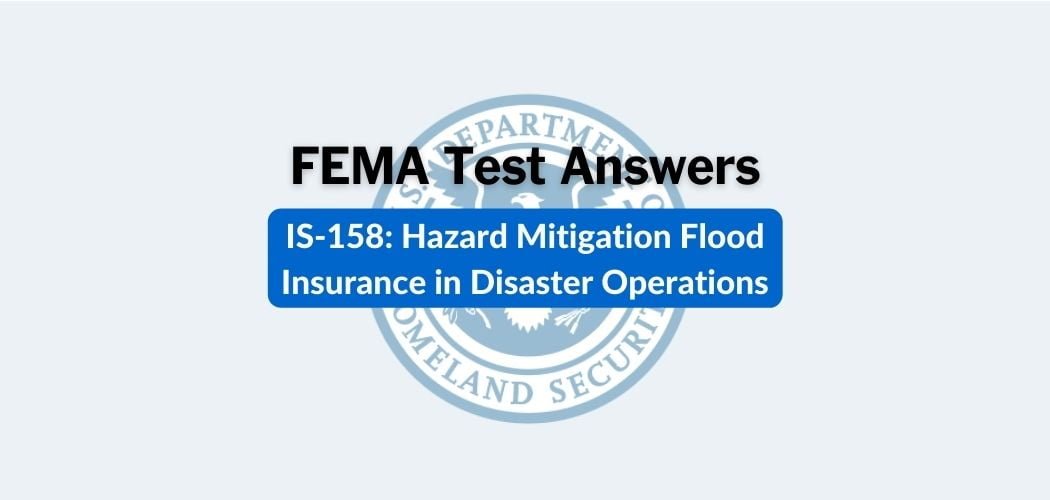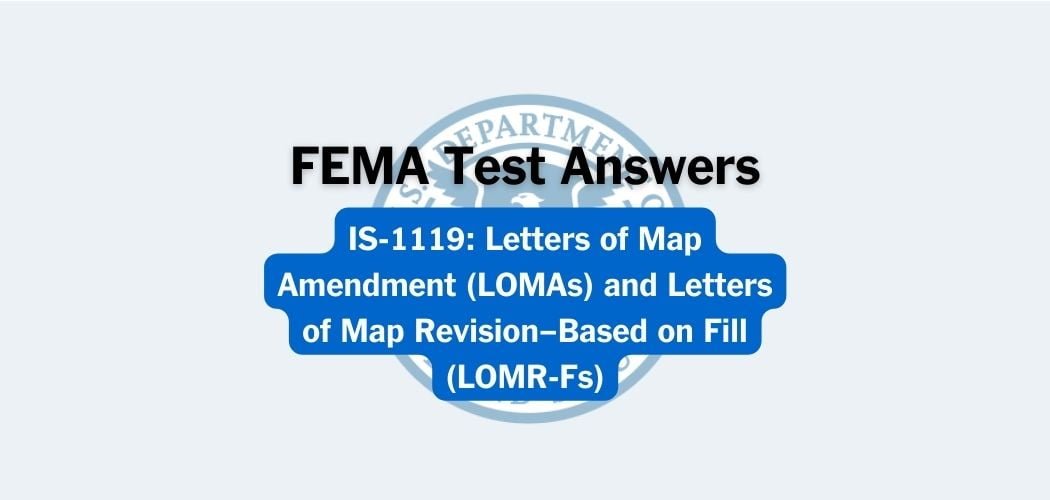Overview: The FEMA IS-556 course was published on 10/31/2013 to build local capacity for damage assessment by enabling the development or refinement of a damage assessment program for the public works agency.
Primary audience: Public works professionals, urban planners, local government officials, and elected officials. It is strongly suggested to take IS-552, The Public Works Role in Emergency Management prior to taking this course.
FEMA IS-556 test answers
Each time this test is loaded, you will receive a unique set of questions and answers. The test questions are scrambled to protect the integrity of the exam.
Question 1. Which of the following is the best choice for a potential member of the local damage assessment response team?
A. School Administrator
B. Code Enforcement Official✅
C. City Manager
D. Emergency Management Director
Question 2. Which of the following is an example of critical infrastructure or key resource that the public works agency would likely be responsible for in a community?
A. Retail store
B. Electric power system
C. Movie theatre✅
D. Apartment building
Question 3. In Washington County, 8 to 10 inches of rain fell in two days. Roads and bridges were washed away by the raging floodwaters.
A. Use more individuals from the community as members of the damage response teams
B. Distracters needed
C. Use photos and videos to document the damage following each storm✅
D. Have state and federal officials interview local citizens about the damage
Question 4. Which of the following would be the best potential member of the local damage assessment planning team?
A. Local store owners
B. Apartment managers
C. First responders✅
D. Local homeowners
Question 5. Which of the following is the LEAST relevant area to be included in training for the local damage assessment response teams?
A. Planning✅
B. Public works assignments
C. Personal safety
D. Data collection
Question 6. Which of the following is a recommended resource that provides training for local damage assessment?
A. FEMA’s Emergency Management Institute✅
B. Professional associations
C. Local Emergency Management Agency
D. All of the above
Question 7. Which of the following best describes the difference between a hazard and vulnerability?
A. A hazard is a potentially dangerous or harmful situation; vulnerability is a description of how exposed or susceptible an asset is to damage.✅
B. A hazard is a potentially dangerous or harmful situation; vulnerability may be categorized as natural or as adversarial/human-caused.
C. A hazard is the estimated impact on people, services, facilities, and structures in a community; vulnerability is a description of how exposed or susceptible an asset is to damage.
D. A hazard depends on the asset’s construction, contents, economic value, and replacement/repair costs; vulnerability is the estimated impact on people, services, facilities, and structures in a community.
Question 8. Which list is the correct order for the steps in the process of conducting a hazard analysis?
A. Identify hazards, inventory assets, profile hazards, estimate losses
B. Inventory assets, estimate losses, identify hazards, profile hazards
C. Identify hazards. profile hazards, inventory assets, estimate losses✅
D. Inventory assets, identify hazards, profile hazards, estimate losses
Question 9. What should be changed as a part of maintaining the damage assessment plan?
A. Forms and data should be updated.
B. Modify training and exercises to suit current data.
C. Near misses should be documented as a means to evaluate effectiveness.
D. All of the above.✅
Question 10. Which of the following is NOT a recommended method of documenting damage assessment information for the community, agency, or organization?
A. Surveys of local residents
B. Conversation with Federal officials
C. Photo documentation of property damage✅
D. Interviews with first responders
Question 11. Risk and vulnerability assessment records indicate that there are hazardous materials stored in some of the facilities located in an industrial area that has been damaged by a tornado. You are unsure of whether any hazardous materials could have leaked onto the ground or into the air. As a member of the damage assessment response team, how should you initially respond to this situation? Select the best response.
A. Identify critical infrastructure and key resources that have been damaged✅
B. Contact neighboring communities with which your community has mutual aid agreements
C. Note the date and time you are conducting your assessment
D. Report the potentially hazardous materials leak as a life safety issue
Question 12. Which of the following best describes the purpose of damage assessment?
A. Determines the vulnerability of critical infrastructure and key resources to hazards.
B. Provides estimated damage and repair costs based solely on property values.
C. Determines where to direct resources and what resources are needed.✅
D. Provides information to the community about impending damage.
Question 13. Which of the following provides the best description of the value of an after-action report?
A. Resolves issues through the development of concrete corrective actions✅
B. Provides documentation to be filed in case of a future audit
C. Addresses opportunities for improvement of plans and procedures
D. Focuses on whom to blame for a failed attempt at implementing the plan
Question 14. Which of the following best describes the difference between a risk assessment and a vulnerability assessment?
A. Risk assessments answer, ‘How and where could each hazard event affect the community?’ Vulnerability assessments answer, ‘What could happen to adversely impact the community?’
B. Risk assessments answer, ‘What could happen to adversely impact the community?’ Vulnerability assessments answer, ‘How and where could each hazard affect the community?’
C. Risk assessments consider how each potential hazard will affect critical infrastructure and key resources; vulnerability assessments provide information about all the hazards that are likely to occur.✅
D. Risk assessments and vulnerability assessments both provide information about what hazards are likely to occur in the community, and both include information about impacts on critical infrastructure.
Question 15. Which of the following best describes the guidelines for establishing local standards for damage assessment?
A. You should develop a 10-point damage assessment scale
B. Data collection procedures should be established according to available resources✅
C. You must use only a 4-point damage assessment scale
D. Local standards can be established without regard to other guidelines
Question 16. Which of the following is NOT a common planning step for a damage assessment program?
A. Identify damage assessment zones
B. Determine plan components and assumptions
C. Submit documentation to the state✅
D. Gather historical hazard information
Question 17. How can the community and the damage assessment response team be better prepared to deal with the human impact of disaster?
A. Learn to recognize the signs of stress and how to manage it✅
B. Prepare for an increased demand for mental health services
C. Plan for provision of Critical Incident Stress Management
D. All of the above
Question 18. Which of the following is NOT one of the main priorities that most communities include as a planning assumption in the damage assessment plan?
A. Property
B. The environment
C. Life
D. Recreation areas✅
Question 19. Which of the following best describes the value of training and exercises to a local damage assessment program?
A. Allows for the analysis of only the strengths in the plan
B. Allows planners to see areas for improvement to the program✅
C. Provides input for individual performance reviews
D. Decreases the need for inter- and intra-agency coordination
Question 20. What is the role of public works in the damage assessment planning process?
A. Public works should include their agency’s damage assessment plan as a part of the community’s damage assessment plan.✅
B. Public works should develop a damage assessment plan for the agency independent of other existing plans in the community.
C. Public works should not be a part of the planning process for the community because the agency develops its own damage assessment plan.
D. Public works should develop a damage assessment plan for the agency and for the community that prescribes specific details of exact reactions to different events.
Question 21. Which of the following best describes the information that risk and vulnerability assessments can provide?
A. An evaluation of how the hazards identified could affect your community
B. Measurement of a community’s response capabilities
C. Detailed and accurate data that can be used for damage assessment documentation✅
D. Prescribed response actions for each hazard identified in the analysis
Question 22. Which of the following is one of the basic principles for effective training and exercises?
A. Exercises should focus on working within one agency
B. Evaluation should be focused only on individual performance
C. Exercises should test all aspects of the plan✅
D. Questions and problems should move from complex to simple
Question 23. Which of the following best explains how damage assessment information is used after an event?
A. It helps to identify areas for improvement in the damage assessment program✅
B. It is kept on file as documentation but not used any further
C. It sets priorities at the beginning of the process but is soon replaced by Federal data
D. It is an optional part of the application for a Presidential Disaster Declaration
Question 24. Which of the following areas should NOT be focused on while conducting a visual inspection for initial damage assessment (i.e., a windshield survey)?
A. Amounts of debris
B. Impacts on utilities
C. Structural damages
D. Interior damages✅



